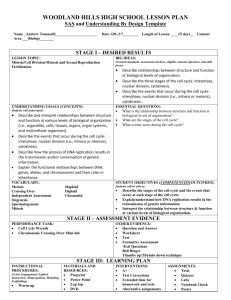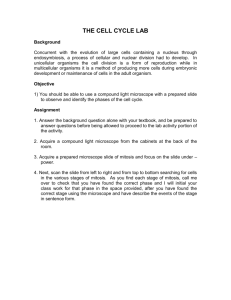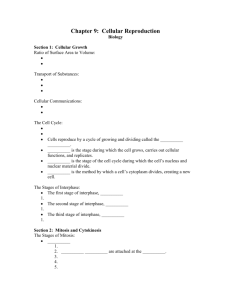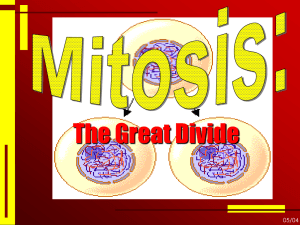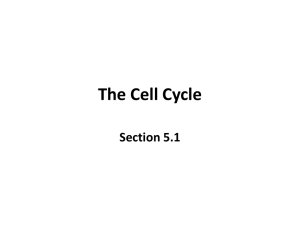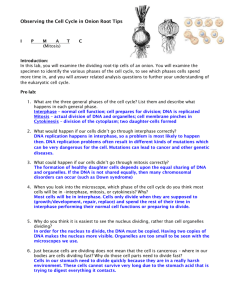The cell cycle consists of four distinct phases: G1 phase, S phase
advertisement
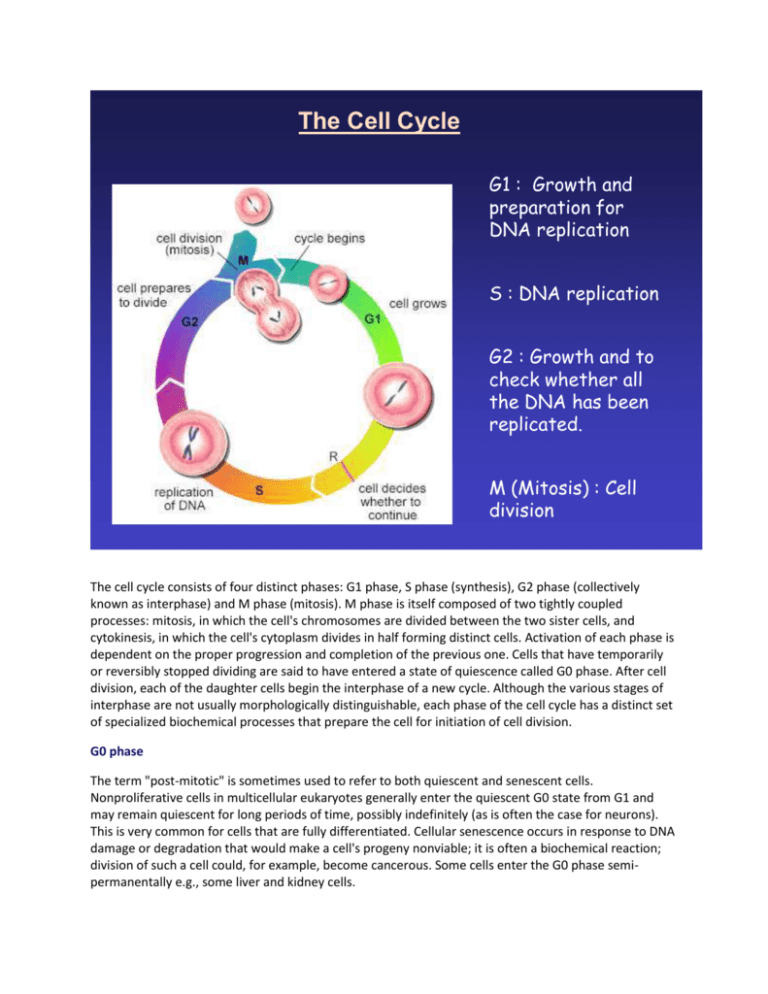
The Cell Cycle G1 : Growth and preparation for DNA replication S : DNA replication G2 : Growth and to check whether all the DNA has been replicated. M (Mitosis) : Cell division The cell cycle consists of four distinct phases: G1 phase, S phase (synthesis), G2 phase (collectively known as interphase) and M phase (mitosis). M phase is itself composed of two tightly coupled processes: mitosis, in which the cell's chromosomes are divided between the two sister cells, and cytokinesis, in which the cell's cytoplasm divides in half forming distinct cells. Activation of each phase is dependent on the proper progression and completion of the previous one. Cells that have temporarily or reversibly stopped dividing are said to have entered a state of quiescence called G0 phase. After cell division, each of the daughter cells begin the interphase of a new cycle. Although the various stages of interphase are not usually morphologically distinguishable, each phase of the cell cycle has a distinct set of specialized biochemical processes that prepare the cell for initiation of cell division. G0 phase The term "post-mitotic" is sometimes used to refer to both quiescent and senescent cells. Nonproliferative cells in multicellular eukaryotes generally enter the quiescent G0 state from G1 and may remain quiescent for long periods of time, possibly indefinitely (as is often the case for neurons). This is very common for cells that are fully differentiated. Cellular senescence occurs in response to DNA damage or degradation that would make a cell's progeny nonviable; it is often a biochemical reaction; division of such a cell could, for example, become cancerous. Some cells enter the G0 phase semipermanentally e.g., some liver and kidney cells. Interphase Before a cell can enter cell division, it needs to take in nutrients. All of the preparations are done during the interphase. Interphase proceeds in three stages, G1, S, and G2. Cell division operates in a cycle. Therefore, interphase is preceded by the previous cycle of mitosis and cytokinesis. Interphase is also known as preparatory phase. In this stage nucleus and cytosol division does not occur. The cell prepares for division. G1 phase The first phase within interphase, from the end of the previous M phase until the beginning of DNA synthesis is called G1 (G indicating gap). It is also called the growth phase. During this phase the biosynthetic activities of the cell, which had been considerably slowed down during M phase, resume at a high rate. This phase is marked by the use of 20 amino acids to form millions of proteins and later on enzymes that are required in S phase, mainly those needed for DNA replication. Duration of G1 is highly variable, even among different cells of the same species. It is under the control of the p53 gene. S phase The ensuring S phase starts when DNA replication commences; when it is complete, all of the chromosomes have been replicated, i.e., each chromosome has two (sister) chromatids. Thus, during this phase, the amount of DNA in the cell has effectively doubled, though the ploidy of the cell remains the same. During this phase, synthesis is completed as quickly as possible due to the exposed base pairs being sensitive to external factors such as any drugs taken or any mutagens (such as nicotine).[2] G2 phase During the gap between DNA synthesis and mitosis, the cell will continue to grow. The G2 checkpoint control mechanism ensures that everything is ready to enter the M (mitosis) phase and divides Mitosis (M Phase/Mitotic phase) The relatively brief M phase consists of nuclear division (karyokinesis). The M phase has been broken down into several distinct phases, sequentially known as: prophase, metaphase, anaphase, telophase cytokinesis (strictly speaking, cytokinesis is not part of mitosis but is an event that directly follows mitosis in which cytoplasm is divided into two daughter cells)
